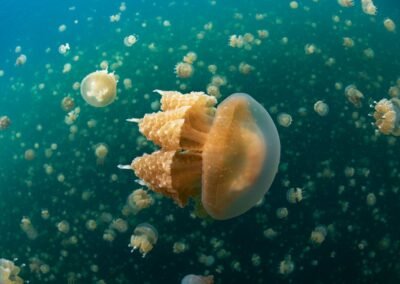Arrival Airport
Koror (ROR)
Departure Airport
Koror (ROR)
Embarkation Port
Disembarkation Port

Palau is home to some of the best scuba diving sites in the world, and a 10-night liveaboard trip is the perfect way to experience them all.
One must-see destination is Blue Corner, where strong currents attract an abundance of marine life, including sharks, barracudas, and schools of fish. Another popular site is German Channel, where manta rays can often be spotted. The Ulong Channel is another highlight, featuring a narrow passage between two islands with incredible coral formations and diverse marine life. The Chandelier Cave, with its unique underground chambers and air pockets, is also not to be missed. For those seeking a unique experience, Jellyfish Lake is home to thousands of harmless jellyfish that can be swum amongst.
Palau truly has something for everyone, and a liveaboard trip is the perfect way to explore all of its breathtaking diving sites.
Recommendation on Diver’s Qualifications
Please note that this itinerary will involve diving in currents. We recommend that our guests have:
- A minimum of 50 logged dives
- Nitrox certification
- Experience with diving in currents
Disclaimer
We wish to show you the best diving possible; however, a number of factors determine which route the Cruise Director and Captain will choose and which dive sites we visit. Weather conditions, tides, currents and the number of other dive vessels at a particular site all play a part in where the boat is heading to. While we attempt to ensure the number of dives we have scheduled is fulfilled, bad weather can hinder the yacht’s ability to reach a specific dive site in our scheduled time. The safety of all on board is paramount and we always do our best to offer diving at alternative sites, should we be unable to visit the sites listed below.
A Typical Day
The diving day has a typical schedule as follows:
06:00
06:30 — 07:00
08:30
10:30
12:30
14:30
16:00
19:00
OR
18:30 — 19:00
20:30
Itineraries
The following is a description of some of the dive sites we may visit during your liveaboard safari on board M/Y Black Pearl.
Day 01
Day 02 - 03
Day 04
Day 05 - 06
Day 07 - 08
Day 09 - 10
Day 11 / Last Day
Day 1
While you enjoy your welcome drink, we will give you a general boat briefing. After finishing all the paperwork, we will show you your home for the week. Just after dinner around 6PM, we give you a safety briefing. No diving the first day.
Day 2 - 3
Ulong Channel, Siaes Corner, Siaes Tunnel, Shark City
Day 4
German Channel
Day 5 - 6
Blue Corner, Blue Holes, New Drop Off, Big Drop Off
There are large pelagic fishes, divers can expect to meet great numbers of Jacks, Big Eyes and Blue Fin Trevallies, Black Fin Barracudas, and Snappers. Also, divers are able to see Sharks, Tunas, wahoos, Groupers, Eagle Rays, Hump head Wrasses, Green Turtles, and Hawksbill Turtles! The coral life is also fantastic on this site – accompanied by Leafy Scorpionfish, Nudibranchs, Moray Eels, Lionfish, Boxing Crab, and Anemone Fish. It is the strong tidal currents that nourish the chain of life at Blue Corner, making it so special. It is recommended to have at least an advanced diving license to fully enjoy this beautiful site.
We will do at least 2 dives at Blue Corner over the next two days, because there is always something new to see and experience with each outgoing and incoming tide.
After lunch, head out for a dive at New Drop Off, a wall dive with a strong current that attracts large pelagic species like sharks and rays.
Day 7 - 8
Peleliu
(may be omitted for 8-day 7-night Best of Palau itinerary)
Overall, Peleliu offers a diverse range of dive sites that are suitable for all levels of divers. The island’s history, combined with its stunning underwater scenery, makes it a popular destination for divers visiting Palau.
Day 9 - 10
Wrecks, Short Drop off, and Chandelier Cave
(may be omitted for 8-day 7-night Best of Palau itinerary)
The Iro is approximately 143 meters/469 feet long, with the hull and superstructure largely intact. Divers can swim through the cargo holds, engine rooms, and living quarters, exploring the wreckage up close. The site is known for its abundant marine life, with schools of fish, including snappers and jacks, frequently seen around the wreck. Barracudas, groupers, and lionfish are also common sightings, along with a variety of smaller critters like nudibranchs, flatworms, and shrimp.
The site is recommended for experienced divers due to its depth and currents that can be present at times.
The site is suitable for divers of all levels, with the seaplane accessible to even novice divers. The calm waters of the lagoon also make it an ideal location for snorkeling.
We will spend the night anchored in the Malakal Harbor area. The afternoon is free time for guests to dry their equipment, or have some fun with Stand Up Paddle boarding, kayaking or snorkeling. Guests are required to ensure they have a minimum of 24 hours between their final dive and the scheduled time of departure of their flights out of Malakal.
Day 11 / Last Day
Departure
Disembark the liveaboard around 08:00 AM after breakfast and transfer to Koror International Airport/next hotel for your next destination.








